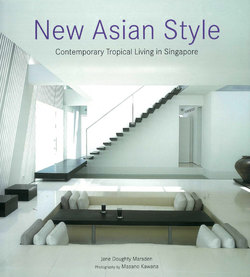Читать книгу New Asian Style - Jane Doughty Marsden - Страница 10
На сайте Литреса книга снята с продажи.
ОглавлениеSpirit Level
Restraint as well as risk characterize the design of this refined home by Justin Hill of Kerry Hill Architects (KHA), Singapore. An exciting synergy of interior and exterior was achieved by Hill and the Tongs-two surgeons and their teenage daughter.
At the main entrance, two water gardens lap a granite walkway, creating the illusion of walking over water, a typical Asian concept. The sense of ceremony is heightened by a dense double door with a wooden bolt, reminiscent of Chinese courtyard houses, complemented by a slatted double door leading to the central courtyard. "Although this is a formal entrance the clients agreed to leave it partially open to the elements, reflecting the tropical climate as well as Singapore's slightly more casual lifestyle to that of other Asian countries," notes Hill.
A seemingly natural progression of space is one of the tenets of zen philosophy, which welcomes ambiguities between indoors and outdoors, and between public and private spaces. Such blurred divisions are underlined both in the layout and materials. The two main axes of the house provide wonderful vistas from, respectively, the living area through the courtyard to the dining room and the painstakingly tended Japanese garden; and from the much-used piano, through the living area, down the hall and the garden again. Malaysian balau wood, limestone and granite feature extensively inside and out, while green Chinese slate roof tiles lend a subtle Oriental nuance.
Only a few pieces of the owners' collection of traditional Chinese furniture from their previous home, a conservation shophouse in Emerald Hill, were timeless and streamlined enough to make the transition.
Much thought also went into selecting the glinting glass mosaic tiles for the pool: "We wanted a dark blue green as in Tian Hu (Heavenly Lake) in the Tian Shan mountains in Xinjiang," says the owner. Even nature conspired to create a consistently beautiful theme; algae staining the ribbed concrete pool wall a glowing copper shade which matches the timber louvres.
The chenggal-wood, oversized front door-flanked by two potted mandarin trees on the outside-confers a sense of entry.
Delaying the arrival into the central courtyard for feng shui purposes and dramatic effect, a slatted chenggal door affords transparency as well as privacy.
The first main axis runs from the living space through the courtyard to the dining room. Dense bamboo and other tropical plants are glimpsed over and through a blind at the far end of the dining room.
Levels of meaning. The view from the piano platform through the living area down the partially open hall to the Japanese-style garden. Tatami mats signal the fun and informality of the owners' piano soirees. Open on three sides, the living space features simple modern furniture in teak and natural fabrics (from The Lifeshop, Singapore and Xtra Living, Singapore) except for a few family heirlooms including a 'moonstone' marble and blackwood footstool and an altar table.
Symbolizing ripples of sand or waves, this piece in Portland stone by London-based Singaporean sculptor Kim Lim looks different depending on the light spilling into the display alcove in the living area.
A few well-chosen, beautiful manmade artefacts such as this glass sculpture by Singapore's Tan Sock Fong make strong statements throughout the house.
Indented with a basin, an island topped with stainless steel is the centrepiece of the light, airy kitchen. Stainless steel shelving and utensils give the room an industrial feel.
In the indoor-outdoor sitting/dining area adjacent to the dining room, water apples in stunning hand-blown glass by Potterhaus Singapore spell simple elegance.
Table in waiting. Austere furnishings complement the dining room's strong lines and light. Asymmetrical facing walls, comprising adjustable louvres opening onto an informal sitting area on one side and a wall of cupboards on the other, add interest. Foliage from the garden and sculptural flowers such as these calla lilies adorn the dining set from Xtra Living, Singapore.
Water fall: seemingly suspended in mid-air, the infinity pool challenges logical perspective in a perfect zen paradox. A clever extension of the internal stairway from the living area to the downstairs study, these external stairs hug the ridged concrete pool wall: "The owners and I spent hours sticking timber strips into the cement to achieve the desired effect," recalls Hill. Poolside, teak furniture is a delightfully sensuous contrast to concrete tiles. Leading to the downstairs study, polished limestone stairs are flanked by local chenggal wood and extend below the glass wall. Adjustable by hand, full-length louvres outside the main study below the living area allow quick response to climatic changes. Fully motorized articulated screens in the same wood shield at least two-thirds of the house, a study in openness in planning and contents. The infinity-edge pool disguises boundaries to give an illusion of endless space.
Inspired by Japanese rock gardens (karesansui) but without even the embellishment of raked lines, much of the granite and gravel hardscape surrounding the house was designed by KHA, Singapore.
Benchmark of style. Reminiscent of the open-plan lobby of a five-star tropical resort, the entertainment pavilion has lofty ceilings with exposed Indonesian teak-clad beams and full-length sliding glass doors. A rosewood bench on which Claire slept as a child (centre) and a gold and black painting of three 'eggs' representing the Hos' children by Thai artist Khun Pong Thai are highlights.
